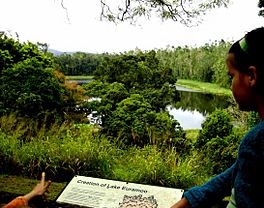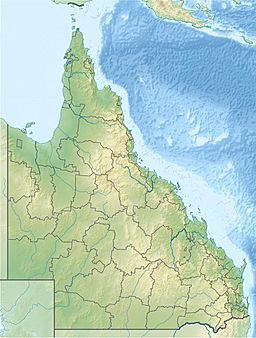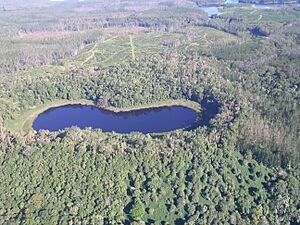Lake Euramoo facts for kids
Quick facts for kids Lake Euramoo (Ngimun) |
|
|---|---|

view from road site viewing platform
|
|
| Location | Danbulla, Tablelands Region, Far North Queensland, Australia |
| Coordinates | 17°09′33″S 145°37′44″E / 17.1591°S 145.629°E |
| Type |
|
| Primary inflows | no inflow channels |
| Primary outflows | no outflow channels |
| Catchment area | 4.4 ha (11 acres) |
| Basin countries | Australia |
| Average depth |
|
| Surface elevation | 718 m (2,356 ft) |
Lake Euramoo is a special lake in Far North Queensland, Australia. It's shaped like a dumbbell and is a type of volcanic crater lake called a maar. This lake was created around 23,000 years ago by two huge explosions. These explosions happened when super-hot groundwater burst out from underground.
Local Aboriginal groups, the Yidinji and Ngadjon-jii people, have their own names for the lake. The Yidinji call it Ngimun, and the Ngadjon-jii call it Nuta. The name 'Euramoo' comes from the Dyirbal word for river, yuramu.
Today, Lake Euramoo is part of the Danbulla National Park and State Forest. It's located on the Atherton Tableland, which is a high area in the Wet Tropics of Queensland World Heritage Area.
Contents
How Lake Euramoo Was Formed
The Yidinji and Ngadjon-jii people have amazing stories about how Lake Euramoo (Ngimun) and two other nearby crater lakes, Lake Eacham (Yidyam) and Lake Barrine (Barany), were formed. These stories are part of their oral history.
Scientists have found that these stories are surprisingly accurate. They describe volcanic eruptions or explosions that happened around 10,000 years ago.
The Myth of Creation
One story tells how two young men broke a rule and made the rainbow serpent Yamany angry. Yamany was a very important spirit in that area.
Because of this, the land where people were camping began to change. The ground roared like thunder, and a strong wind blew. The earth twisted and cracked open. At the same time, a strange red cloud appeared in the sky. People tried to run, but they were swallowed by the cracks in the ground.
After telling this myth in 1964, a storyteller mentioned that the land around the lakes was "not jungle - just open scrub" when this happened. Later, in 1968, a scientist named Peter Kershaw studied the lake's sediments. He found that the rainforest in that area is only about 7,600 years old. This suggests the area was indeed more open after the volcanic event, just as the story describes.
Plants Around Lake Euramoo
The area around Lake Euramoo (Ngimun) is covered by a type of moist rainforest. This rainforest is a small part of what used to be a much larger forest. In the last 50 years, some cleared land nearby has been replanted with native Hoop Pine trees and other types of conifers. Other areas have been naturally regrown by the rainforest plants.
Common Rainforest Plants
Within 100 meters of Lake Euramoo, you can find many interesting rainforest plants. Some common types include:
- Araliaceae family plants, like Polyscias australiana and Heptapleurum actinophyllum.
- Araucariaceae family plants, such as Agathis robusta.
- Moraceae family plants, like different types of Ficus (fig trees).
- Elaeocarpaceae family plants, for example, Elaeocarpus grandis.
- Euphorbiaceae family plants, like Aleurites moluccana and Macaranga species.
- Myrtaceae family plants, such as Austromyrtus species and Eugenia cormiflora.
- Rubiaceae family plants, including Flindersia brayleyana and Euodia bonwickii.
Aquatic Plants in the Lake
Around the edge of Lake Euramoo, there are different "zones" of water plants. These zones change depending on how deep the water is and the time of year.
- Right at the lake's edge, rainforest lianas (climbing vines) like Parsonsia species mix with tall swamp grasses called Phragmites australis.
- A bit further out, where there's less shade from the trees and fewer vines, you'll find Hibiscus species and Ludwigia species. These grow in water up to about 1 meter deep.
- Even further from the edge, there are plants rooted in the lake bottom, floating mats of vegetation, and finally, up to 30 meters from the shore, you'll see floating water plants. These are mainly Nymphoides species.



